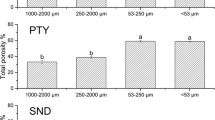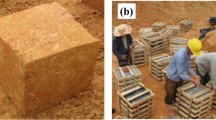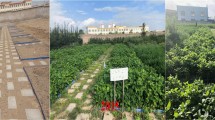Abstract
Purpose
Recent trends in soil green and sustainable remediation require an increased attention on environmental effects. The physical consequences of remediation practices on soil structure are very rarely investigated.
Material and methods
A laboratory experiment was carried out by adding iron grit to a sand (S), a silt loam (L), and a clay (C) soil subjected to several wetting-drying cycles. The physical effects of the treatment on soil pore system were identified and quantified combining physical measurements on repacked samples with image analysis of pores on resin-impregnated soil blocks and micromorphological analysis on thin sections.
Results and discussion
A negligible reduction of total porosity (P) resulted in S, and a slight increase was observed in the L and C soils. However, an important impact on soil structure was identified in pore size range >10 μm for the L and C soils, with the formation of new pores related to the differential shrink-swell behavior between soil matrix and added iron grains. Different plasticity of these soils also played a role in planar pore formation.
Conclusions
Effects of the addition of iron grit on soil pore system are strongly dependent on soil physical properties. The performed experiment showed that iron-based amendments can improve soil structure in low-plastic shrink-swell soil increasing porosity in the range of transmission pores (50–500 μm).
This study showed the high potential of soil micromorphology and pore image analysis in order to evaluate the environmental impact of soil remediation practices.


Similar content being viewed by others
References
Adriano DC, Wenzel WW, Vangronsveld J, Bolan NS (2004) Role of assisted natural remediation in environmental cleanup. Geoderma 122:121–142
Bradshaw A (2000) The use of natural processes in reclamation—advantages and difficulties. Landsc Urban Plan 51:89–100
Bronick CJ, Lal R (2005) Soil structure and management: a review. Geoderma 124:3–22
Cundy AB, Hopkinson L, Whitby RLD (2008) Use of iron-based technologies in contaminated land and groundwater remediation: a review. Sci Total Environ 400:42–51
European Environment Agency (2007) Progress in management of contaminated sites. Report CSI 015 Copenhagen, Denmark
Fitzpatrick EA (1993) Soil microscopy and micromorphology. Wiley, Chichester
Gee GW, Or D (2002) Particle-size analysis. In: Dane JH, Topp GC (eds) Soil Science Society of America Book Series: vol. 5, Methods of soil analysis. Part 4. Physical methods. Madison, WI, pp 255–293
Goecke P, Ginocchio R, Mench M, Neaman A (2011) Amendments promote the development of Lolium perenne in soils affected by historical copper smelting operations. Int J Phytorem 13:552–566
Greenland DJ (1977) Soil damage by intensive arable cultivation: temporary or permanent? Philos Trans R Soc Lond 281:193–208
Hanauer T, Felix-Henningsen P, Steffens D, Kalandadze B (2011) In situ stabilization of metals (Cu, Cd, and Zn) in contaminated soils in the region of Bolnisi, Georgia. Plant Soil 341:193–208
Hartley W, Lepp NW (2008a) Remediation of arsenic contaminated soils by iron-oxide application, evaluated in terms of plant productivity, arsenic and phytotoxic metal uptake. Sci Total Environ 390:35–44
Hartley W, Lepp NW (2008b) Effect of in situ soil amendments on arsenic uptake in successive harvests of ryegrass (Lolium perenne cv Elka) grown in amended As-polluted soils. Environ Pollut 156:1030–1040
Hartley W, Edwards R, Lepp NW (2004) Arsenic and heavy metal mobility in iron oxide- amendment contaminated soils as evaluated by short and long term leaching test. Environ Pollut 131:495–504
Hashim MA, Mukhopadhyay S, Sahu JN, Sengupta B (2011) Remediation technologies for heavy metal contaminated groundwater. J Environ Manag 92:2355–2388
Hillel D (1980) Fundamentals of soil physics. Academic Press, New York
Horgan GW (1998) Mathematical morphology for analyzing soil structure from images. Eur J Soil Sci 49:161–173
Kumpiene J, Lagerkvist A, Maurice C (2008) Stabilization of As, Cr, Cu, Pb and Zn in soil using amendments—a review. Waste Manag 28:215–225
Loeppert RH, Suarez DL (1996) Carbonate and gypsum. In: Sparks DL (ed) Methods of soil analysis, part 3, chemical methods SSSA Book Ser. 5. American Society of Agronomy and Soil Science Society of America, Madison
McKeague JA, Guertin RK, Valentine KWG, Belisle J, Bourbeau GA, Howell A, Michalyna W, Hopkins L, Page F, Bresson LM (1980) Estimating illuvial clay in soils by micromorphology. Soil Sci 129:386–388
Mele G, Basile A, Leone AP, Moreau E, Terribile F, Velde B (1999) The study of soil structure by coupling serial sections and 3D image analysis. Modeling of transport processes in soils. In: Feyen and Wiyo K (eds) Workshop of EurAgEng’s field of interest on soil and water, Leuven, pp 103–117
Mench M, Vangronsveld J, Beckx C, Ann R (2006) Progress in assisted natural remediation of an arsenic contaminated agricultural soil. Environ Pollut 144:51–61
Murphy CP (1983) Point counting pores and illuvial clay in thin section. Geoderma 31:133–150
Pagliai M, Vignozzi N (2003) Image analysis and microscopic techniques to characterize soil pore system. In: Blahovec J, Kutilek M (eds) Physical methods in agriculture. Kluwer Academic Publisher, Dordrecht, pp 13–38
Peech M (1965) Hydrogen-ion activity. In: Black CA (ed) Methods of soil analysis, part 2. American Society of Agronomy and Soil Science Society of America, Inc, Madison
Pini R, Pedron F, Petruzzelli G, Scatena M, Guidi GV (2009) Modifications of the structural characteristics of new soil forming on industrial waste colonized by woody plants. Geoderma 149:373–378
Rhoades JD (1996) Salinity: electrical conductivity and total dissolved solids. In: Sparks DL (ed) Methods of soil analysis, part 3, chemical methods SSSA Book Ser. 5. American Society of Agronomy and Soil Science Society of America, Madison
Rizzi L, Petruzzelli G, Poggio G, Guidi GV (2004) Soil physical changes and plant availability of Zn and Pb in a treatability test of phytostabilization. Chemosphere 57:1039–1046
Serra J (1982) Image analysis and mathematical morphology. Academic Press, London
Soil Survey Division Staff (1993) Soil survey manual. Soil Conservation Service Handbook 18, chapter 3. US Department of Agriculture
Summer ME, Miller WP (1996) Cation exchange capacity and exchange coefficients. In: Sparks DL (ed) Methods of soil analysis, Part 3, chemical methods SSSA Book Ser. 5. American Society of Agronomy and Soil Science Society of America, Madison
TRANSVALOR (2000) Micromorph version 1.4 CMM. Ecole des Mines, Armines
United States Environmental Protection Agency (US EPA) (2008) Green remediation: Incorporating sustainable environmental practices into remediation of contaminated sites; p 1. Available online at http://www.clu-in.org/download/remed/greenremediation-primer.pdf
Velde B (1999) Structure of surface cracks in soil and muds. Geoderma 93:101–124
Walkley A, Black IA (1934) An examination of the Degtjareff method for determining organic carbon in soils: effect of variations in digestion conditions and of inorganic soil constituents. Soil Sci 63:251–263
Wilson MJA (1987) Handbook of determinative methods in clay mineralogy. Chapman and Hall, New York
Wong MH (2003) Ecological restoration of mine degraded soils, with emphasis on metal contaminated soils. Chemosphere 50:775–780
Acknowledgment
The authors thank Dr. A. Basile and Dr. R. De Mascellis from CNR-ISAFOM for the help in the study of shrinkage characteristic and the granulometry measures of the soils, respectively; B. Di Matteo from CNR-ISAFOM for the preparation of the soil thin sections; and Dr. S. Vingiani from the University Federico II of Naples for the support in mineralogical analysis of the soils.
Author information
Authors and Affiliations
Corresponding author
Additional information
Responsible editor: Rainer Horn
Giacomo Mele is the co-first author.
Rights and permissions
About this article
Cite this article
Gargiulo, L., Mele, G. & Terribile, F. Effects of iron-based amendments on soil structure: a lab experiment using soil micromorphology and image analysis of pores. J Soils Sediments 14, 1370–1377 (2014). https://doi.org/10.1007/s11368-014-0894-4
Received:
Accepted:
Published:
Issue Date:
DOI: https://doi.org/10.1007/s11368-014-0894-4




